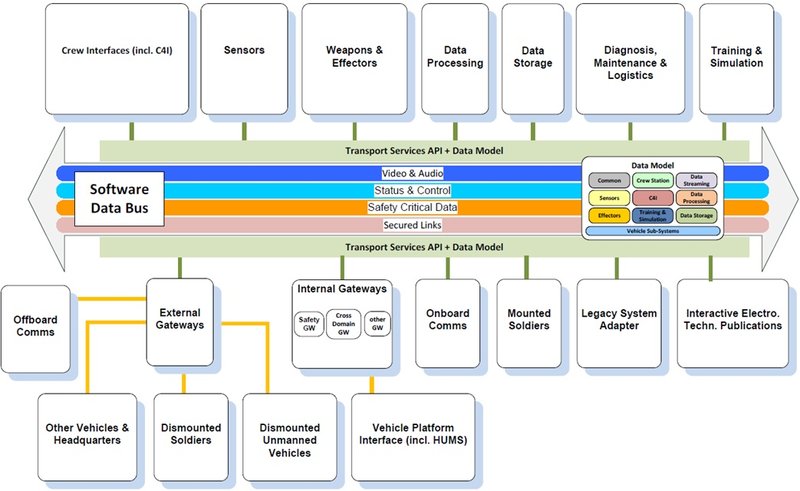Need sensor fusion on the move?
This article is brought to you by Systematic
The proliferation of sensors across the battlefield means that the amount of data generated has exponentially increased. With military vehicles acting in a variety of roles such as reconnaissance and armed scout, troop carriers, and combat, leveraging the data that their onboard sensor systems provide can help the mounted commander maximise their situational awareness while remaining inside the vehicle.
What is the best way to ensure that these sensors can best work together, while also minimising the hardware demands and the need for implementation of proprietary protocols and standards that they create? On-board facilities, such as electricity generators, computer systems, as well as other resources such as transmission bandwidth, are facing increased pressure, meaning that smarter ways of working need to be undertaken.
Enter the concept of Generic Vehicle Architecture (GVA).
Supporting generic vehicle architecture
Modern GVA promotes the idea that data is to be in the centre, and systems and applications can be both consumers and providers of data. The design seeks to lay the foundation to avoid direct system-to-system and system-to-sensor integrations by describing a common approach based on data, use cases/workflows, and using the same technology for exchanging data. Maximising the principles of GVA, the variety of sensors and subsystems can also be utilised more effectively.
“Under earlier vehicle design and subsystem integration practices, systems sometimes each required their own sensor for essentially the same data, which also meant duplicated integration into the overall vehicle architecture,” Christoph Pauls, Business Product Manager at Systematic, said. “Under the concept of GVA, this could be simplified. For example, a vehicle may have had multiple GPS receivers to provide the position to the radios, battle management system, inertial navigation system, remote controlled weapons stations, and so on. Under GVA principles only one GPS receiver system is needed, and its data is easily shared out to each subsystem through a common software data bus.”
This means that there is a reduction in cabling and external antennas, as well as reduced power consumption to support these common subsystems. This can support positive changes in other areas such as reductions in overall vehicle weight, added space availability for extra loads, increased protection, or improved ergonomics for passengers. Other benefits can include easier maintenance and a reduced number of components that can break and potentially undermine vehicle availability.

Source: NATO Standard AEP-4754 NATO Generic Vehicle Architecture (NGVA) For Land Systems
Data communication under GVA
In-vehicle data exchange is governed through the Land Data Model, allowing for specified information to be transferred over standardised interfaces such as ethernet cables. Enabling an open systems architecture allows for “interoperability by design,” which can mean both within the vehicle’s own subsystems, as well as simplifying cross-platform standardization of data and intelligence processing and sharing.
SitaWare Frontline, Systematic’s battle management system (BMS) designed for mounted commanders, has been designed from the outset as a modular and extendable system to allow for easy integration with various radios, sensors, and vehicle and weapons stations. An open and well-documented API and software development kit also allows original equipment manufacturers to smooth the integration journey, and supports customer choice in vehicle subsystems and equipment, while futureproofing SitaWare Frontline equipped vehicles.
SitaWare Tactical Communication bridges between the vehicle components and the GVA backbone (the Data Distribution Service, DDS) underpinning the integration between the BMS, radio systems, and vehicle, weapon, and sensor interfaces. Integrations with external sensors and systems can be saved and reused on other GVA-compliant vehicles, thereby reducing the costs of redevelopment on vehicles developed to the same GVA standard.
SitaWare Frontline as an ISR tool
As the variety of sensor and effector systems are integrated, the ability for the vehicle commander to improve their situational awareness through a single screen is dramatically increased.
Sensor data gathered by a vehicle can be rapidly disseminated automatically to SitaWare Insight, feeding into a data lake and being assessed as part of a regular intelligence cycle by analysts. Vehicle commanders operating SitaWare Frontline are then able to take advantage of the resulting analysis to change mission plans dynamically or reorient rapidly to address new threats. As a result, a SitaWare Frontline equipped armoured vehicle can be a powerful asset to any mission, being able to rapidly improve and support situational awareness.
The modular and open architecture of SitaWare Frontline and SitaWare Tactical Communication, both being compatible with the approaches set out by GVA, can support a faster and easier integration of ISR sensors, thereby aiding this workflow from the beginning already. The creation of standards and open architectures under GVA also enables governments to make smarter investments, reducing costly integration work and helping to de-risk subsystem integration.
The seamless integration across the SitaWare suite of products – including the SitaWare Edge product for dismounted forces – allows for enhanced battle management, situational awareness, and intelligence sharing across the combat environment. This vertical integration also allows for greatly reduced risk in acquisition and installation management, with the SitaWare suite also enjoying a high degree of hardware agnosticism and reducing the need for multiple user interfaces.
The Systematic Software Development Kits allow both governments and equipment manufacturers to undertake this work to allow for seamless installation, meaning that the work can be done more openly than other BMS providers may allow.
More from Industry Spotlights
-
![“Adversaries have adapted”: how counter-UAS and space control will decide future conflicts]()
“Adversaries have adapted”: how counter-UAS and space control will decide future conflicts
In conversation... EOS's Andreas Schwer talks to Shephard's Ben Watts about how the Australian company is shifting its strategic focus to two technologies it sees as essential for success on the modern battlefield - C-UAS and space control.
-
![Tiltrotor: The Long-Range Maneuver Solution]()
Tiltrotor: The Long-Range Maneuver Solution
If competition turns to conflict, the United States, along with its allies and partners, must be prepared to confront peer and near-peer competitors capable of achieving parity in military capability.
-
![Introducing the MITR-M1 Half Mask: Tactical respiratory protection for every scenario]()
Introducing the MITR-M1 Half Mask: Tactical respiratory protection for every scenario
Counter terrorism, specialist firearms officers, special forces, explosive breaching, drug interdiction, riot control, indoor/outdoor shooting, environmental disaster response, first response, prisons and corrections: tactical operators across law enforcement, first responders, and the military face a vast array of low-mid level respiratory threats in their day-to-day operations.
-
![Need to develop AI-powered red pictures for battlefield situational awareness?]()
Need to develop AI-powered red pictures for battlefield situational awareness?
Leverage Systematic's SitaWare suite to fuse intelligence and share awareness of your opponent’s deployments and capabilities.
-
![Sustain capabilities and secure advantage with advanced Digital Engineering]()
Sustain capabilities and secure advantage with advanced Digital Engineering
CDS Defence & Security optimises defence systems with Digital Engineering and MBPS for peak performance. Learn more today!
-
![Solving production & supply chain challenges with additive manufacturing]()
Solving production & supply chain challenges with additive manufacturing
Boosting supply chain resilience with additive manufacturing: exploring solutions to production and logistics challenges.

























